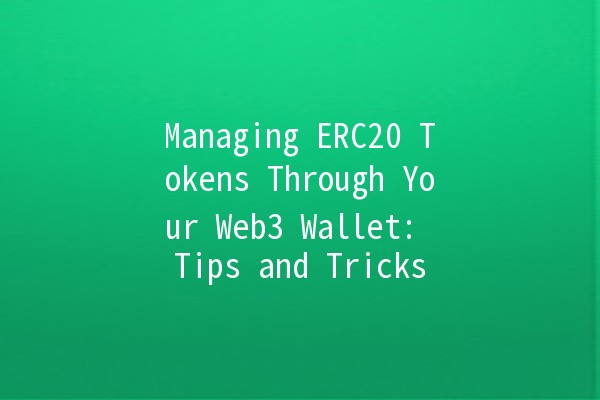
to Web3 Wallets and ERC20 Tokens
The rapid evolution of blockchain technology has shaped a new world of finance and digital assets. At the heart of this innovation are Web3 wallets, powerful tools that enable users to interact with decentralized networks and manage their digital currencies. Among the numerous tokens available, ERC20 tokens have become popular due to their utility and versatility within the Ethereum ecosystem. In this article, we will delve into how to manage ERC20 tokens effectively using a Web3 wallet, providing practical tips that enhance your productivity and streamline your crypto experience.
Understanding Web3 Wallets
A Web3 wallet allows users to interact with decentralized applications (dApps) on the blockchain. Unlike traditional wallets, these wallets grant you full control over your private keys, giving you ownership of your assets. There are several types of Web3 wallets, including:
Browser Extension Wallets: Such as MetaMask, these are easy to install and allow seamless integration with your web browser.

Mobile Wallets: Compatible with smartphones, these wallets offer flexibility and convenience for managing assets on the go.
Hardware Wallets: These offer enhanced security by storing keys offline, making them ideal for longterm crypto investments.
Why ERC20 Tokens Matter
ERC20 tokens are a standard protocol for creating tokens on the Ethereum blockchain. They can represent various assets, including cryptocurrencies, real estate, and even voting rights. The popularity of ERC20 tokens arises from their compatibility with different dApps and exchanges, facilitating seamless transactions and integration.
Productivity Enhancement Techniques for Token Management
One of the simplest yet most effective ways to manage your ERC20 tokens is by organizing them using custom labels. Most Web3 wallets allow you to categorize and label your tokens according to your preferences.
Application Example:
For instance, if you hold multiple utility tokens, you can label them as “Utility Tokens,” while you can categorize stablecoins separately. This visual organization makes it easier to navigate your wallet, especially as your portfolio grows.
Many Web3 wallets now provide builtin swapping features, enabling users to exchange one token for another without going through a separate exchange platform. This feature can save time and transaction fees.
Application Example:
Suppose you want to convert some of your LINK tokens to ETH. Instead of sending your LINK to an exchange, converting it, and then moving the ETH back to your wallet, you can perform the swap directly within your wallet. This not only saves time but also reduces the risk of losing assets during transfers.
Transaction fees on the Ethereum network can fluctuate greatly depending on network demand. By staying informed about current gas prices and adjusting your transaction rates accordingly, you can save significant funds over time.
Application Example:
Use tools like EthGasStation to monitor gas fees. When prices are low, you can execute transactions, whether they involve transferring ERC20 tokens or interacting with dApps, without incurring excessive costs.
Many wallets and financial applications allow users to set price alerts for specific tokens. This feature helps you stay informed about significant market movements without constantly checking prices.
Application Example:
Set an alert for a specific ERC20 token you hold. If the price reaches a predetermined threshold, you’ll receive a notification, allowing you to decide whether to sell, hold, or buy more tokens based on your strategy.
Understanding the technical specifications behind ERC20 tokens can give you valuable insights into their management. Various token standards, such as ERC721 and ERC1155, often integrate features that can influence usability and compatibility with dApps.
Application Example:
By educating yourself about these standards, you can make informed decisions when investing in tokens. For instance, knowing that certain games utilize ERC721 for unique assets could help you gauge the potential value of ingame items.
Security should be a top priority when managing any cryptocurrency, including ERC20 tokens. Regularly backing up your Web3 wallet ensures that you do not lose access to your assets due to unforeseen circumstances such as device failure.
Application Example:
Set a reminder to back up your wallet every few months. Use secure methods to store your seed phrases and private keys, either through encrypted storage or hardware wallets, ensuring only you can access it.
Frequently Asked Questions
ERC20 tokens are digital assets created using the Ethereum blockchain standard. They enable developers to create tokens that can represent anything, from virtual currencies to realworld assets.
You can add ERC20 tokens to your wallet by selecting the “Add Token” feature in your Web3 wallet app, entering the token’s contract address, and verifying its details.
Most Web3 wallets have a builtin swap feature that allows you to easily exchange ERC20 tokens. Simply select the token you wish to swap, enter the amount, and the token you wish to receive.
Gas fees are transaction costs required to execute operations on the Ethereum network. They can affect your overall cost when transferring or swapping tokens, making it essential to monitor them.
To secure your ERC20 tokens, enable twofactor authentication on your wallet, regularly back up your wallet, and avoid sharing your private keys or seed phrases with anyone.
Not all Web3 wallets are created equal. Always choose reputable wallets with positive reviews and community support. Research their security features and user experiences before committing your tokens to any wallet.
Managing ERC20 tokens through a Web3 wallet presents an efficient way to engage with the digital economy. By implementing productivityenhancing techniques such as organizing tokens, utilizing builtin swapping features, monitoring gas fees, setting alerts, educating yourself about token standards, and regularly backing up your wallet, you can maximize your experience in the world of cryptocurrencies. Embrace these practices, and you will not only simplify your token management but also enhance your overall engagement in the exciting landscape of blockchain technology.

